 |
PO
Box 9021, Wilmington, DE 19809, USA
E-mail: font@focusonnature.com
Phone: Toll-free in USA 1-888-721-3555
or 302/529-1876 |
 Birds
of EUROPE
Birds
of EUROPE
Sandgrouse to Buntings
Noting those found during
Focus On Nature Tours
with an (*)
1992 thru 2015
including
the Canary Islands off Africa,
and Turkey, in Asia Minor
Part 2 of a Europe Bird List compiled by Armas Hill,
with some photos
Upper right photo: EUROPEAN
ROBIN
451 birds have cumulatively
been seen during FONT European tours. A few of the birds in the following list
are distinctive subspecies.
There have been 58 FONT birding tours in Europe, with 25 in Spain, and 20 in Iceland.
Link: Part
#1 of this list of Birds
in Europe: Grouse to Puffin
Codes (in following list):
In the list that follows, relating to sightings during FONT tours, the country
and the months are noted.
BU:
Bulgaria
CI:
Canary Islands (Spain)
HU: Hungary
IC: Iceland
PO: Poland
RM: Romania (inc. "Transylvania")
SL:
Slovakia
SP:
Spain,
including nearby Andorra:
AN,
France:
FR,
Gibraltar:
GR,
Morocco:
MR,
& Portugal:
PG
SW:
Sweden
TU:
Turkey
The following 2 sets
of designations by Birdlife International:
(t): a globally threatened or
rare species
(t1): critical
(t2): endangered
(t3): vulnerable
(nt): a near-threatened species globally
(Ee): endangered in Europe
(Ev): vulnerable in Europe
(Er): rare in Europe
(Ed): has recently declined in Europe
(El): localized in Europe
(i): an introduced species
(Vme): vagrant from the Middle East
(Vna): vagrant from North America
(Vsib): vagrant from Siberia
(ph): species with a photo in the FONT website
Links:
Upcoming FONT Birding & Nature Tours in Europe
FONT Past Tour Highlights
A
List of European Mammals (with some photos)
Directory of Photos in this Website
Links to Bird-Lists for particular European countries:
Bulgaria
Iceland
the Canary Islands
Spain Sweden

Bird-List:
- Pin-tailed Sandgrouse (Ee) (*) ______ SP:jun
Pterocles a. alchata
- Black-bellied Sandgrouse (Ev) (*) ______ CI:jul
SP:jan,jun
Pterocles o. orientalis (except CI)
Pterocles orientalis aragonica (CI)
Rock Pigeon / Feral Pigeon (i) (*)(*) ______
AN:jun BU:may CI:jun,jul FR:jun
GR:jun HU:may IC:may,jun,sep,oct PG:sep PO:apr,may
RM:may SL:may SP:jan,apr,jun,jul,sep,oct,dec SW:sep TU:aug
Columba livia (except CI)
Columba l. canariensis (CI)
Stock Dove (or Stock Pigeon)
(*) ______
BU:may PO:apr,may RM:may SP:jun SW:sep TU:aug
Columba o. oenas
Common Wood Pigeon (*) ______ BU:may
HU:may PO:apr,may RM:may SL:may
SP:jan,apr,jun,sep,oct,dec SW:sep TU:aug
Columba p. palumbus
Bolle's Pigeon (t3) (Ev) (*) ______ CI:jun,jul
Columba bolli (monotypic)
Another name for Columba bolli
has been Dark-tailed Laurel Pigeon.
Laurel Pigeon (t3) (Ev) (*) ______ CI:jun,jul
Columba junoniae
(monotypic)
Another name for Columba junoniae
has been White-tailed Laurel Pigeon.
Eurasian Collared Dove (*) ______ BU:may
CI:jun,jul HU:may PG:sep PO:apr,may RM:may
SL:may SP:jan,apr,jun,jul,sep,oct,dec SW:sep
TU:aug
Streptopelia d. decaocto
African Collared Dove (i) (*) ______ CI:jun
Streptopelia roseeogrosea
European Turtle Dove (Ed) (*) ______
AN:jun BU CI:jun,jul HU:may PO:may SP:jun,jul TU:aug
Streptopelia t. turtur
Laughing Dove (*) ______
TU:aug
Streptopelia senegalensis ermanni
Another name for Streptopelia
senegalensis is Palm Dove.
Monk Parakeet (i) (*) ______
CI:jul SP:jun
Myiopsitta monachus cotorra
Rose-ringed Parakeet (i) (*) ______ TU:aug
Psittacula krameri
Great Spotted Cuckoo (*) ______ BU:may
SP:jun,sep
Clamator glandarius (monotypic)
Common Cuckoo (*) ______ AN:jun
BU:may HU:may PO:apr,may RM:may SL:may SP:apr,jun,jul
Cuculus c. canorus (except most of
SP)
Cuculus canorus bangsi (most of SP)
Barn Owl (Ed) (*) (ph) ______
CI:jun,jul HU:may PO:apr SP:jan
Tyto a. alba
(1 of 2 subspecies in CI)
The Barn Owl of the Old World has been said to be
distinct from the American Barn Owl, Tyto
furcata, which is a heavier bird, with a larger and stouter
head and body, and with much more powerful talons.
Eurasian Eagle-Owl (Ev) (*) ______
BU:may
HU:may SP:apr,jun,sep
Bubo b. bubo
(except SP)
Bubo bubo hispanus (SP)
Northern Long-eared Owl (*) (ph) ______
BU:may HU:may PO:may
Asio o. otus
Short-eared Owl (Ev) (*) (ph) ______
HU:may IC:jun SW
Asio f. flammeus
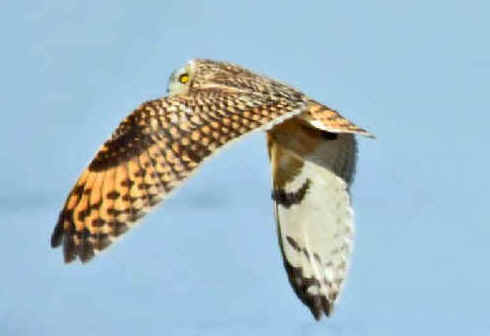
Above & below: Short-eared Owls
(upper photo by Howard Eskin; lower photo by
Kim Steininger)
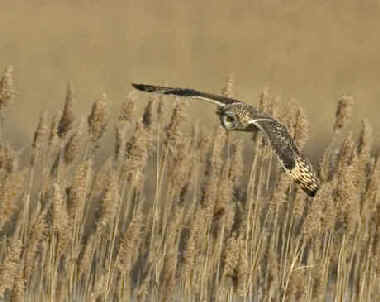
Eurasian Scops Owl (Ed) (*) ______
BU:may FR:jun HU:may RM:may SP:apr,jun
Otus s. scops
Little Owl (Ed) (*) (ph) ______ BU:may
HU:may PO:may
SP:jan,apr,jun,sep TU:aug
Athene noctua indigena
(BU,TU)
Athene n. noctua (HU,PO)
Athene noctua vidalii (SP)
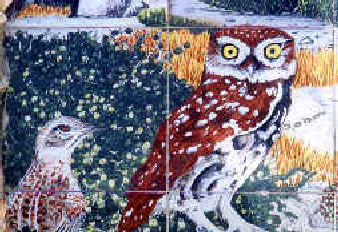
A painting of a Little Owl & a Dupont's Lark on a wall in Spain
Tawny Owl (*) ______ HU:may
PO:apr,may SP:jan
Strix a. aluco
(except SP)
Strix aluco sylvatica (SP)
Ural Owl (*) (ph) ______ HU:may
PO:apr,may
Strix uralensis liturata

It's there, in the crevice - a roosting Ural Owl
Tengmalm's Owl (*) (ph) ______
PO:apr SL:may
Aegolius f. funereus
Aegolius funereus
is called Boreal Owl in North America.
Eurasian Pygmy Owl (*) ______
PO:may
Glaucidium p. passerinum
European Nightjar (Ed) (*) ______ BU:may
HU:may PO:may SP:oct
Caprimulgus europaeus
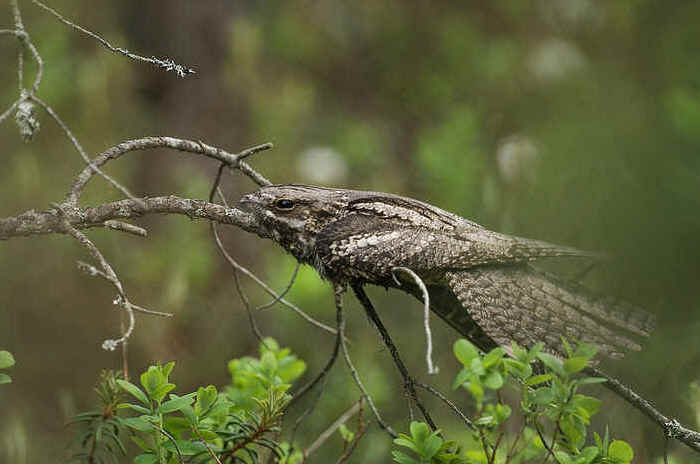
European Nightjar
Red-necked Nightjar (*) ______ SP:jun
Caprimulgus ruficollis
Common Swift (*) ______
AN:jun BU:may CI:jun FR:jun HU:may PO:may
SL:may SP:apr,jun,jul
SW:sep TU:aug
Apus a. apus
Alpine Swift (*) ______ BU:may
RM:may SP:apr,jun,sep TU:aug
Tachymarptis m. melba (formerly Apus m. melba)
Pallid Swift (*) ______
BU:may CI:jun,jul SP:jun TU:aug
Apus pallidus illyricus (BU,TU)
Apus pallidus brehmorum (CI,SP)
White-rumped Swift (*) ______ SP:jun
Apus caffer (monotypic)
Little Swift (*) ______
MR
Apus affinis galilejensis
Plain Swift (*) ______
CI:jun,jul
Apus unicolor (monotypic)
Common Kingfisher (Ed) (*) (ph) ______ HU:may SP:jun,oct,dec SW
TU:aug
Alcedo atthis ispida
(except TU)
Alcedo a. atthis (TU)
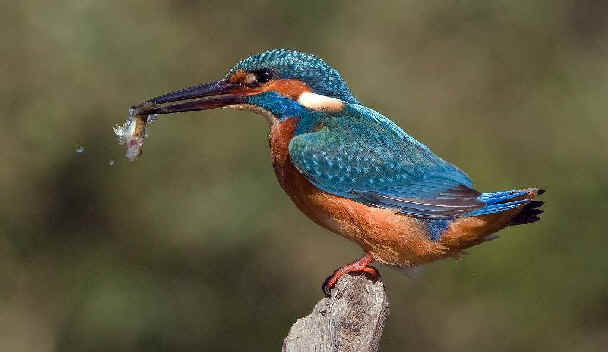
Common Kingfisher
European Bee-eater (Ed) (*) (ph) ______ BU:may
HU:may PO:may SP:apr,jun TU:aug
Merops apiaster (monotypic)
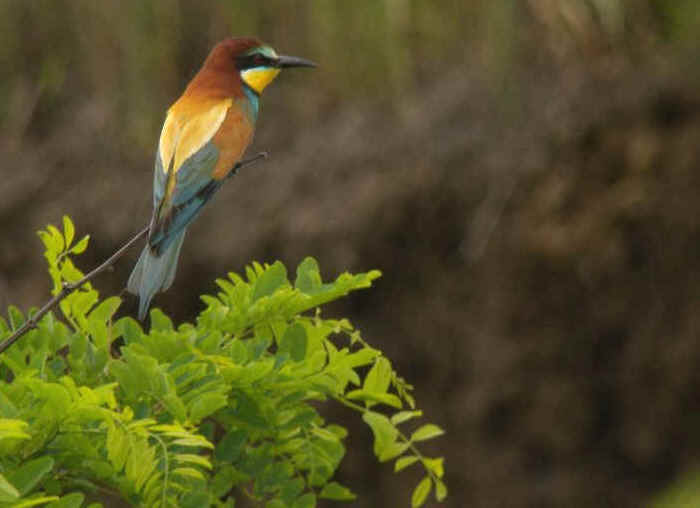
European Bee-eater
(photo by Przemyslaw Kunysz)
European Roller (Ed) (*) ______ BU:may
HU:may PO:may SP:jun TU:aug
Coracias g. garrulus
Eurasian Hoopoe (*) ______
BU:may HU:may PO:apr,may RM:may SP:apr,jun,jul,sep,dec
TU:aug
Upupa e. epops
Eurasian Wryneck (Ed) (*) ______
BU:may HU:may PO:apr,may RM
SL:may SP
Jynx t. torquilla
Black Woodpecker (*) (ph) ______
BU:may HU:may PO:apr,may RM:may SP SW:sep
Dryocopus martius

This Black Woodpecker,
oddly in flight over the golf course
at Falsterbo,
the southernmost point in Sweden, where
other species fly south during the fall in migration.
This bird did not continue across the Baltic, but turned back.
(photo during the
Sept 2007 FONT Sweden tour by James Scheib)
Grey-headed Woodpecker (Ed) (*) ______
BU:may HU:may PO:apr,may RM:may
Picus c. canus
European Green Woodpecker (Ed) (*)
______ BU:may HU:may PO:apr,may RM:may SP:jan,apr,jun SW:sep
Picus viridis
Iberian Green Woodpecker ______
SP:janapr,jun
Picus sharpei
The Iberian Green Woodpecker has been split from the European
Green Woodpecker.
Syrian Woodpecker (*) ______
BU:may HU:may PO:apr,may RM:may TU:aug
Dendrocopos s. syriacus
Great Spotted Woodpecker (*) (ph) ______
AN:jun BU:may
CI:jun HU:may PO:apr,may RM:may SL:may SP:apr,jun,sep SW:sep
TU:aug
Dendrocopos m. major
(PO,SW)
Dendrocopos major pinetorum (BU,HU,RM,SK,TU)
Dendrocopos major hispanus (SP)
Dendrocopos major canariensis (CI) subspecies
endemic to Tenerife Island in the Canaries
Middle Spotted Woodpecker (*) ______
BU:may HU:may PO:apr,may RM:may TU:aug
Dendrocopos m. medius
Lesser Spotted Woodpecker (*) ______
BU:may HU:may PO:apr SW:sep TU:aug
Dryobates m. minor (formerly Dendrocopos m. minor)
(SW)
Dryobates minor hortorum (formerly Dendrocopos minor hortorum)
(BU,HU,PO)
Dryobates minor danfordi (formerly Dendrocopos minor danfordi)
(TU)
White-backed Woodpecker (*) ______
HU:may PO:apr,may
Dendrocopos l. leucotos
Eurasian Three-toed Woodpecker (Ed)
(*) (ph) ______
PO:apr,may RM:may SL:may
Picoides tridactylus
The Eurasian Three-toed Woodpecker was conspecific with the American
Three-toed Woodpecker, Picoides dorsalis.
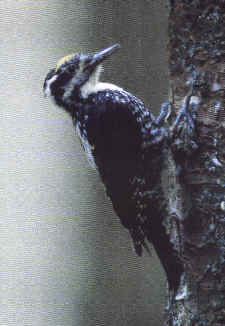
Eurasian Three-toed Woodpecker
Northern Grey Shrike (*) (ph) ______
PO:apr,may RM:may SW:sep
Lanius e. excubitor (SW)
Lanius excubitor homeyeri (PO, RM)
Another name for Lanius excubitor
has been Great Grey Shrike. In North America, it is called Northern
Shrike.
Southern Grey Shrike (Ed) (*) ______
CI:jun,jul PG:sep SP:jan,apr,jun,sep,oct,dec
Lanius m. meridionalis (except
CI)
Lanius meridionalis koenigi subspecies endemic in the
Canary Islands
The Southern Grey Shrike was conspecific with the Northern Grey
Shrike (above). In the Asian part of its range. Lanius
meridionalis is called the "Steppe
Shrike".
Lesser Grey Shrike (Ed) (*) ______ BU:may
HU:may RM:may TU:aug
Lanius minor
Masked Shrike (Ev) (*) ______ BU:may
Lanius nubicus
Woodchat Shrike (Ev) (*) ______ BU:may
SP:apr,jun TU:aug
Lanius s. senator (except SP)
Lanius senator rutilans (SP)
Red-backed Shrike (Ed) (*) (ph) ______
AN:jun BU:may FR:jun HU:may
PO:apr,may RM:may SL:may SP TU:aug
Lanius c. collurio
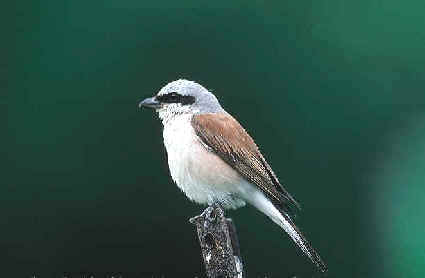
Two photographs of Red-backed Shrikes
(photo below by Przemyslaw Kunysz)
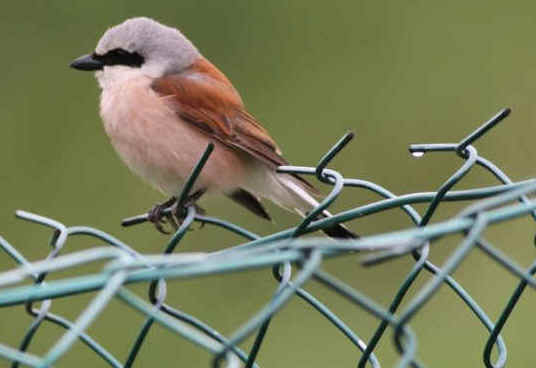
Eurasian Golden Oriole (*) ______
BU HU:may PO:may RM:may SL:may
SP:jun TU:aug
Oriolus o. oriolus
Eurasian Jay (*) ______ AN:jun
BU:may
FR:jun HU:may PO:apr,may RM:may SL:may SP:jan,apr,jun,sep SW:sep
TU:aug
Garrulus g. glandarius (except
TU and most of SP)
Garrulus glandarius fasciatus (most of SP)
Garrulus glandarius ferdinandi (European TU)
Garrulus glandarius anatoliae (Asian TU)
Spotted Nutcracker (*) ______
BU:may HU:may PO:apr,may RM:may
SL:may SW:sep
Nucifraga c. caryocatactes
Iberian Magpie (i?) (*) ______ SP:apr,jun,sep,dec
Cyanopica cooki
The Iberian Magpie has been considered conspecific with the Azure-winged
Magpie of eastern Asia.
Eurasian Magpie (*) (ph) ______
AN:jun BU:may FR:jun HU:may PG:sep PO:apr,may RM:may
SL:may SP:jan,apr,jun,jul,sep,oct,dec SW:sep TU
Pica p. pica (except most of SP)
Pica pica melanotos (most of SP)
The Eurasian Magpie was conspecific with the Black-billed
Magpie of North America, Pica hudsonia.
Also split from Pica pica have
been the Oriental Magpie, Pica sericea
and the Kamchatka Magpie, Pica camtschatica,
both in far-eastern Asia.
Red-billed Chough (Ev) (*) ______
FR SP:jan,apr,oct
Pyrrhocorax pyrrhocorax erythrorhamphus
Alpine Chough (*) ______ AN:jun
SP TU:aug
Pyrrhocorax g. graculus
Northern Raven (*) (ph) ______
AN:jun BU:may
CI:jun,jul FR:jun HU:may IC:may,jun,sep,oct PO:apr,may RM:may
SL:may
SP:jan,apr,jun,sep,oct,dec SW:sep TU:aug
Corvus c. corax
(except CI, IC, TU,
and most of SP)
Corvus corax canariensis a rare subspecies
endemic in the Canary Islands
Corvus corax varius (IC)
Corvus corax laurenci (TU)
Corvus corax hispanus (most of SP)
Rook (*) (ph) ______ BU:may
HU:may PO:apr,may RM:may SW:sep TU:aug
Corvus f. frugilegus
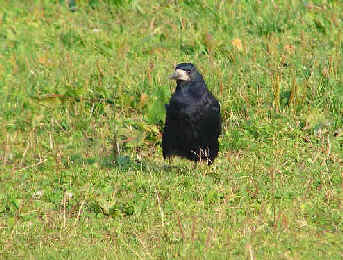
A Rook photographed during the
September 2007 FONT Sweden tour
(photo by James
Scheib)
Hooded Crow (*) (ph) ______ BU:may
HU:may PO:apr,may RM:may SW:sep TU:aug
Corvus cornix
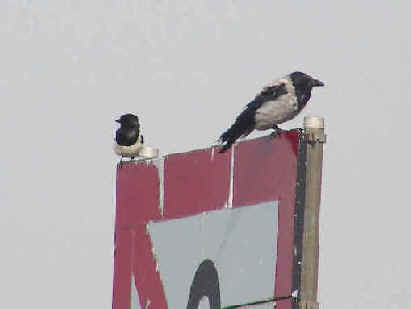
2 Corvids
at once during the September 2007 FONT Sweden tour:
the Eurasian Magpie (left); the Hooded Crow (right)
(photo by James Scheib)
Carrion
Crow (*) ______ AN:jun FR:jun SP:apr,jun,sep,oct,dec
Corvus corone
Western Jackdaw (*) (ph) ______
BU:may HU:may PO:apr,may RM:may
SP:jan,apr,jun,sep,dec SW:sep TU:aug
Coloeus m. monedula (formerly Corvus) m. monedula)
(except SP and TU)
Coloeus monedula spermologus (formerly Corvus monedula spermologus)
(SP)
Coloeus monedula soemmerringii (formerly Corvus monedula soemmerringii)
(TU)
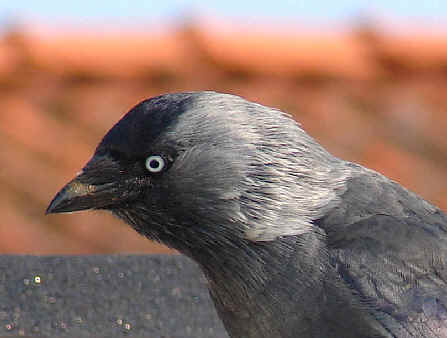
Western Jackdaw
(photograph by Andy Ednie)
Bohemian Waxwing (*) ______ PO:apr
Bombycilla g. garrulus
Northern Great Tit (*) (ph) ______ BU:may
HU:may PO:apr,may RM:may
SP:jan,apr,jun,sep,oct,dec SW:sep TU:aug
Parus m. major (except south
SP)
Parus major corsus (south SP)
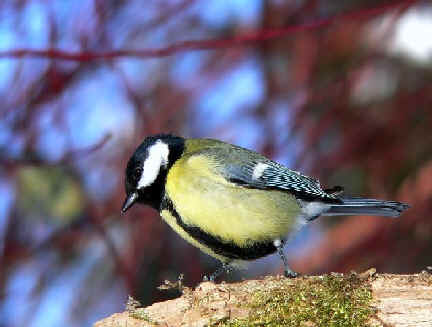
Northern Great Tit
(photo by Howard Eskin)
Blue Tit (*) (ph) ______ BU:may
HU:may PG:sep PO:apr,may RM:may SL:may SP:jan,apr,jun,sep,oct,dec
SW:sep TU:aug
Cyanistes c. caeruleus (formerly Parus c. caeruleus)
(except central and south SP)
Cyanistes caeruleus ogliastrae (formerly Parus caeruleus ogliastrae)
(central and south SP)
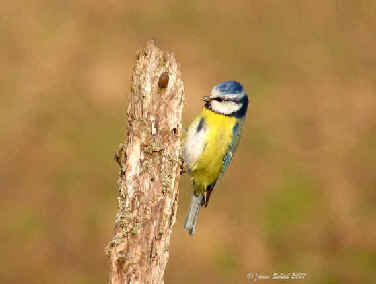
A Blue Tit photographed during a FONT tour in Sweden
(photo by James Scheib)
African Blue Tit (*) _____
CI:jun,jul
Cyanistes untramarinus teneriffae (formerly Parus ultramarinus teneriffae)
(endemic subspecies in
CI, one of 4 endemic subspecies there)
Coal Tit (*) ______
AN:jun BU:may FR PO:apr,may RM:may SL:may SP:apr,jun,sep,oct SW
TU:aug
Periparus a. ater (formerly Parus a. ater)
(except SP)
Periparus ater vieirae (formerly Parus ater vieirae) (SP)
Marsh Tit (*) ______
AN:jun BU:may FR HU:may PO:apr,may RM:may SP SW:sep
TU:aug
Poecile p. palustris (formerly Parus p. palustris)
(except TU)
Poecile palustris stagnatilis (formerly Parus palustris stagnatilis)
(TU)
Willow Tit (*) ______
BU:may PO:apr,may RM:may
SL:may
Poecile m. montanus (formerly Parus m. montanus)
Sombre Tit (*) ______ BU:may
TU:aug
Poecile lugubris anatoliae (formerly Parus lugubris anatoliae)
European Crested Tit (*) ______
AN:jun BU:may FR:jun PO:apr SL:may SP:jan,apr,jun,sep SW TU:aug
Lophophanes c. cristatus (formerly Parus
c. cristatus) (except SP)
Lophophanes cristatus mitratus (formerly Parus cristatus mitratus)
(north SP)
Lophophanes cristatus weigoldi (formerly Parus cristatus weigoldi)
(central and south SP)
Eurasian Penduline-Tit (*) ______
BU:may HU:may PO:apr,may SP:jan
Remiz p. pendulinus
Barn Swallow (Ed) (*) (ph) ______
AN:jun BU:may CI:jun,jul FR:jun
HU:may IC:jun(rare) PO:apr,may
RM:may SL:may SP:jan,apr,jun,jul,sep,oct,dec SW:sep TU:aug
Hirundo r. rustica
Generally, in Europe, Hirundo rustica
is referred to as simply the Swallow.
Red-rumped Swallow (*) ______
BU:may SP:apr,jun,sep TU:aug
Cecropis daurica rufula (formerly Hirundo daurica rufula)
Eurasian Crag Martin (*) ______
AN:jun BU:may FR:jun PG:sep RM SP:jan,apr,jun,sep,oct TU:aug
Ptyonoprogne rupestris
Sand Martin (Ed) (*) ______
BU:may HU:may PO:apr,may SP:apr,jun,jul,oct TU:aug
Riparia r. riparia
Riparia riparia
is called Bank Swallow in North America.
Northern House Martin (*) ______
AN:jun BU:may
CI:jul FR:jun HU:may IC:jun(rare)
PO:apr,may RM:may SL:may
SP:apr,jun,jul,sep,oct SW:sep TU:aug
Delichon u. urbicum
Long-tailed Bushtit (*) ______ BU:may
HU:may PO:apr,may SL:may SP:apr,jun,sep,oct,dec SW:sep TU:aug
Aegithalos c. caudatus (except
BU,HU,SK,SP,TU)
Aegithalos caudatus europaeus (BU,HU,SK)
Aegithalos caudatus tephronotus (TU)
Aegithalos caudatus taiti (north SP)
Aegithalos caudatus irbii (central and south SP)
Aegithalos caudatus
has been called Long-tailed Tit.
Dupont's Lark (Ev) (*) ______ SP
Chersophilus d. duponti
Greater Short-toed Lark (Ev) (*) ______
BU:may HU:may
SP:jan,apr,jun,oct TU:aug
Calandrella b. brachydactyla
(except HU)
Calandrella brachydactyla hungarica (HU)
Lesser Short-toed Lark (Ev) (*) ______
CI:jun,jul SP:jun
Calandrella rufescens apetzii (SP)
Calandrella rufescens polatzeki (1 of 2 subspecies in CI)
Calandra Lark (Ed) (*) (ph) ______ BU:may
PG:sep SP:jan,apr,jun,sep,oct TU:aug
Melanocorypha c. calandra
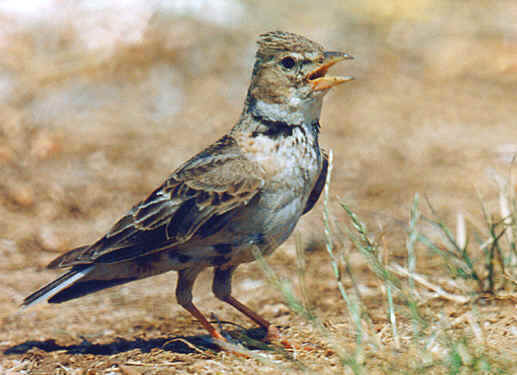
Calandra Lark
Woodlark (Ev) (*) ______ BU:may
FR:jun PO:apr,may RM:may SP:apr,jun SW;sep TU:aug
Lullula a. arborea (except
SP and TU)
Lullula arborea pallida (SP,TU)
Eurasian Skylark (Ev) (*) ______ BU:may
FR:jun HU:may PO:apr,may RM:may SL:may SP:apr,jun,sep SW:sep
TU:aug
Alauda a. arvensis (except
TU and central SP)
Alauda arvensis cantarella (TU)
Alauda arvensis sierrae (central SP)
Crested Lark (Ed) (*) ______
BU:may FR HU:may PG:sep PO:apr,may RM:may
SL:may SP:jan,apr,jun,jul,sep,oct,dec TU:aug
Galerida c. cristata (except
SP and TU)
Galerida cristata pallida (SP)
Galerida cristata caucasica (TU)
Thekla Lark (Ev) (*) ______
SP:jan,apr,jun,sep
Galerida t. theklae
Shore Lark (*) (ph) ______ PO:may
TU:aug
Eremophila alpestris flava (PO)
Eremophila alpestris penicillata (TU)
Eremophila alpestris is
called Horned Lark in North America.
Zitting Cisticola (*) ______ BU:may
SP:jan,apr,jun,jul,oct,dec TU:aug
Cisticola j. juncidis (except
SP)
Cisticola juncidis cisticola (SP)
Cisticola juncidis has also been called Fan-tailed
Warbler, but a non-related species is so-named in Mexico.
Additionally, the cisticolas are now in a family apart from the Old
World Warblers.
Common Grasshopper Warbler (*) ______
BU:may HU:may PO:apr,may
Locustella n. naevia
Cetti's Warbler (*) ______ SP:jan,apr,jun
TU:aug
Cettia c. cetti (except
TU)
Cettia cetti sericea (TU)
Savi's Warbler (*) ______ HU:may
PO:apr,may
SP:apr,jun
Locustella l. luscinioides
River Warbler (*) ______
BU:may HU:may PO:apr,may
Locustella fluviatilis
Marsh Warbler (*) ______ BU:may
HU:may PO:apr,may
Acrocephalus palustris
Eurasian Reed Warbler (*) ______
BU:may
HU:may PG:sep PO:may SP:apr,jun,sep,oct TU:aug Acrocephalus scirpaceus
The former European Reed Warbler is now considered
conspecific with the also former Caspian Reed Warbler, Acrocephalus
fuscus.
Great Reed Warbler (*) ______
BU:may HU:may PO:apr,may
SP:apr,jun,jul TU:aug
Acrocephalus a. arundinaceus
Aquatic Warbler (t3) (Ee) (*) ______
HU:may PO:may
Acrocephalus paludicola
Sedge Warbler (*) ______ BU:may
HU:may PO:apr,may TU:aug
Acrocephalus schoenobaenus
Moustached Warbler (*) ______ BU:may
HU
SP:jun TU:aug
Acrocephalus m. melanopogon
Paddyfield Warbler (*) ______ BU:may
Acrocephalus agricola septimus
Western Olivaceous Warbler (Ev) (*) ______
SP:apr,jun
Iduna opaca (formerly
Hippolais opaca)
Another name for Iduna opaca
is Isabelline Warbler.
The Western Olivaceous Warbler and the Eastern Olivaceous Warbler (below)
have been considered conspecific.
Eastern Olivaceous Warbler (*) ______ BU:may
TU:aug
Iduna pallida elaeica (formerly
Hippolais pallida elaeica)
Olive-tree Warbler (Er) (*) ______
BU:may
Hippolais olivetorum
Melodious Warbler (*) ______
PG:sep SP:jun,sep
Hippolais polyglotta
Icterine Warbler (*) ______
BU:may HU:may PO:may
Hippolais icterina
Common Whitethroat (*) ______
BU:may FR:jun HU:may PG;sep
PO:apr,may
RM:may SP:apr,jun TU:aug
Sylvia c. communis
Lesser Whitethroat (*) ______ BU:may
HU:may PO:apr,may TU:aug
Sylvia c. curruca
Garden Warbler (*) ______ BU:may
PO:may
SP:jun
Sylvia b. borin
Barred Warbler (*) ______ BU:may
HU:may PO:may
Sylvia n. nisoria
Eurasian Blackcap (*) ______
BU:may CI:jun,jul FR:jun HU:may IC:oct PO:apr,may RM:may
SL:may
SW;sep
SP:jan,apr,jun,sep,oct,dec TU:aug
Sylvia a. atricapilla (except
CI and SP)
Sylvia atricapilla obscura subspecies endemic in the
Canary Islands
Sylvia atricapilla pauluccii (SP)
Orphean Warbler (Ev) (*) ______ BU:may
SP:jun
Sylvia hortensis crassirostris
(BU) ("Eastern Orphean
Warbler")
Sylvia h. hortensis (SP)
("Western Orphean
Warbler")
Sardinian Warbler (*) ______ BU:may
CI:jun,jul SP:jan,apr,jun,sep,dec TU:aug
Sylvia m. melanocephala (except CI)
Sylvia melanocephala leucogastra subspecies endemic in
the Canary Islands, one of 2
subspecies there
Subalpine Warbler (*) ______
BU:may SP:apr,jun,sep TU:aug
Sylvia cantillans
Spectacled Warbler (*) ______ CI:jun,jul
SP
Sylvia conspicillata
Dartford Warbler (Ev) (*) ______ SP:jan,apr,jun,sep
Sylvia undata
Willow Warbler (*) ______ BU:may
PO:apr,may SL SP SW TU:aug
Phylloscopus t. trochilus (in western Europe)
Phylloscopus trochilus acredula (in north, central, eastern Europe)
Western Bonelli's Warbler (*) ______ SP;apr,jun
Phylloscopus bonelli
Eastern Bonelli's Warbler (*) ______
BU:may
Phylloscopus orientalis
Wood Warbler (*) ______ BU:may
HU:may PO:apr,may SW
Phylloscopus sibilatrix
Common Chiffchaff (*) ______
BU:may HU:may PG:sep PO:apr,may RM:may
SL:may
SP:jan,apr,sep,oct,dec SW:sep TU:aug
Phylloscopus c. collybita
Phylloscopus collybita abietinus
(these 2 subspecies overlap in migration)
Iberian Chiffchaff (*) ______
AN:jun FR:jun SP:jun
Phylloscopus brehmii
The Iberian Chiffchaff was conspecific with the Common
Chiffchaff (above).
Canary Islands Chiffchaff (*) ______
CI:jun,jul
Phylloscopus c. canariensis (the other Canarian subspecies extinct since the
beginning of the 20th Century)
The Canary Islands Chiffchaff was conspecific with the Common
Chiffchaff (above).
Yellow-browed Warbler (Vsib) (*) (ph) ______ SW:sep
Phylloscopus inornatus
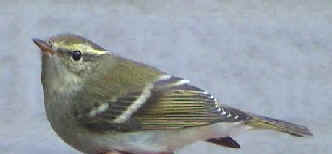
Yellow-browed Warbler
(photo by Tommy Holmgren)
This bird, from Siberia & rare in western Europe, was seen
during FONT tours in Sweden in Oct 1999 & Sep 2006.
Green Warbler (*) ______ TU:aug
Phylloscopus nitidus
Phylloscopus nitidus
was conspecific with the Greenish Warbler,
Phylloscopus trochiloides.
Bearded Reedling (*) ______
BU:may HU:may SP:jun
Panurus b. biarmicus
Panurus biarmicus
has been called Bearded Tit.
Firecrest (*) ______ AN:jun
BU:may FR:jun PO:apr,may RM:may SP:jan,apr
Regulus i. ignicapillus
Goldcrest (*) (ph) ______ BU:may
IC:jun,oct PO:apr,may RM:may SL:may
SP:apr,jun,sep SW;sep TU:aug
Regulus r. regulus (except
TU)
Regulus regulus buturlini (TU)
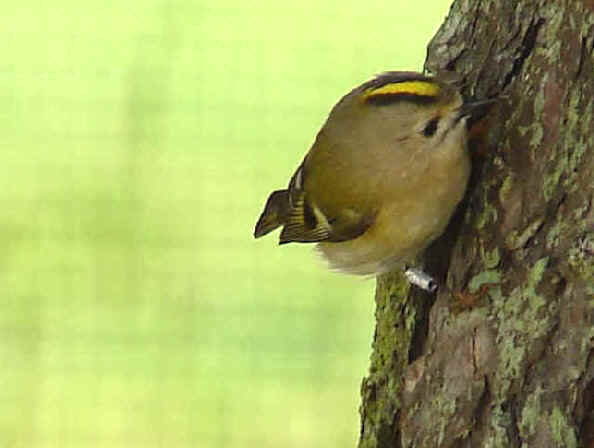
A Goldcrest photographed during a FONT tour in Sweden.
This species, along with the Firecrest, shares the distinction of being
Europe's smallest bird.
(photo by James Scheib)
"Canary Islands Goldcrest"
(*) ______
CI:jun,jul
Regulus regulus teneriffae
Other names for the subspecies of the Goldcrest, Regulus
regulus teneriffae, endemic to the Canary Islands, are Tenerife
Kinglet, or Canarian Kinglet.
Eurasian Wren (*) ______
BU:may HU:may IC:jun,sep,oct PO:apr,may RM:may
SL:may
SP:apr,jun,dec SW:sep TU:aug
Troglodytes (or Nannus) t. troglodytes
(except IC,TU and south SP)
Troglodytes troglodytes islandicus subspecies endemic in
Iceland, the
"Icelandic Wren"
Troglodytes troglodytes cypriotes (TU)
Troglodytes troglodytes kabylorum (south SP)
Eurasian Nuthatch (*) (ph) ______
BU:may HU:may PO:apr,may RM:may
SP:apr,jun,sep SW TU:aug
Sitta e. europaea (PO)
Sitta europaea caesia (BU,HU,RM,SW, north SP)
Sitta europaea hispaniensis (central SP)
Sitta europaea levantina (west TU)
Sitta europaea caucasica (north and east TU)
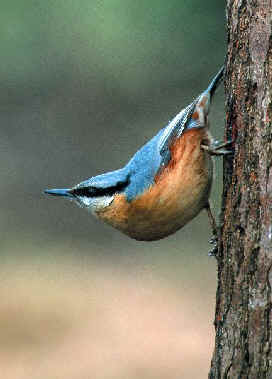
Eurasian Nuthatch
Sitta europaea caesia
(photo by Howard Eskin)
Kruper's Nuthatch (*) ______
TU:aug
a species nearly endemic
to Turkey
Sitta krueperi
Western Rock Nuthatch (*) ______
BU:may TU:aug
Sitta n. neumayer
Wallcreeper (*) (ph) ______ RM:may
SP
Tichodroma m. muraria
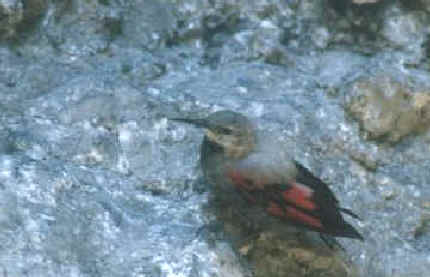
The Wallcreeper
Eurasian Treecreeper (*) ______
AN:jun BU:may HU:may PO:apr,may RM:may SP SW
Certhia f. familiaris (except
SP)
Certhia familiaris macrodactyla (SP)
Short-toed Treecreeper (*) ______
BU:may HU:may PO:apr
SP:jan,apr,sep TU:aug
Certhia b. brachydactyla (except
SP and TU)
Certhia brachydactyla megarhyncha (SP)
Certhia brachydactyla harteri (TU)
Common Starling (*) (ph) ______ BU:may
CI:jun FR:jun HU:may IC:may,jun,sep,oct PO:apr,may RM:may
SL:may SP:jan
SW;sep TU:aug
Sturnus vulgaris
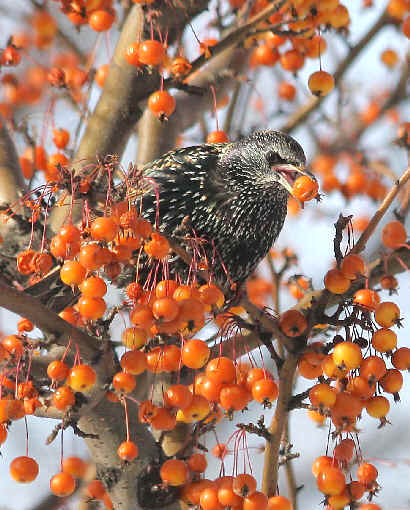
Common Starling
(photo by Doris Potter)
Spotless Starling (*) ______
FR:jun GR:jun PG:sep SP:jan,apr,jun,jul,sep,oct,dec
Sturnus unicolor
Rosy Starling (*) ______ BU:may
IC:oct SW:sep
Pastor roseus (formerly Sturnus roseus)
Another name for Pastor roseus
has been Rose-colored Starling.
Common Myna (i) (*) ______ CI:jul(rare)
SP
Acridotheres tristis
Another name for Acridotheres tristis
is Indian Myna.
Spotted Flycatcher (Ed) (*) ______
BU:may HU:may PO:apr,may
SP:jun,sep TU:aug
Muscicapa s. striata
European Pied Flycatcher (*) (ph) ______ HU
PG:sep PO:apr,may SL:may SP:apr,jun,sep,oct SW:sep
Ficedula h. hypoleuca (except
SP)
Ficedula hypoleuca iberiae (SP)
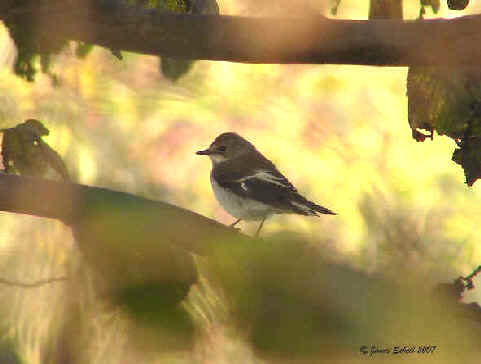
A female European Pied Flycatcher, a migrant photographed during the Sept
07 FONT Sweden tour
(photo by James Scheib)
Collared Flycatcher (*) ______
BU:may HU:may PO:apr,may
Ficedula albicollis
Semicollared Flycatcher (Ee)
(*) ______ BU:may
Ficedula semitorquata
Red-breasted Flycatcher (*) ______
BU:may PO:apr,may SW:sep
Ficedula parva
The Red-breasted Flycatcher was conspecific with what is now
the Taiga Flycatcher of eastern Asia, Ficedula
albicilla.
Whinchat (*) ______
AN:jun BU:may FR:jun HU:may PG:sep PO:apr,may RM SP:sep SW:sep
TU:aug
Saxicola rubetra
Eurasian Stonechat (Ed) (*) ______ BU:may
HU:may PG;sep PO:apr,may RM:may SP:jan,apr,jun,sep,oct,dec TU:aug
Saxicola torquatus rubicola
Canary Islands Bush Chat (nt) (Ev)
(*) ______
CI:jun,jul
Saxicola d. dacotiae (the other Canarian subspecies, S.d.murielae, is now
extinct)
Other names for Saxicola dacotiae
are Fuerteventura Chat or Canarian Chat.
Northern Wheatear (*) (ph) ______ AN:jun
BU:may
FR:jun HU:may IC:may,jun,sep,oct PO:apr,may RM:may SP:apr,jun,sep SW;sep
TU:aug
Oenanthe o. oenanthe (except
IC & TU)
Oenanthe oenanthe leucorrha (IC)
Oenanthe oenanthe libanotica (TU)

Above & below: the Northern Wheatear, in flight & on the ground
(photos by Howard Eskin)
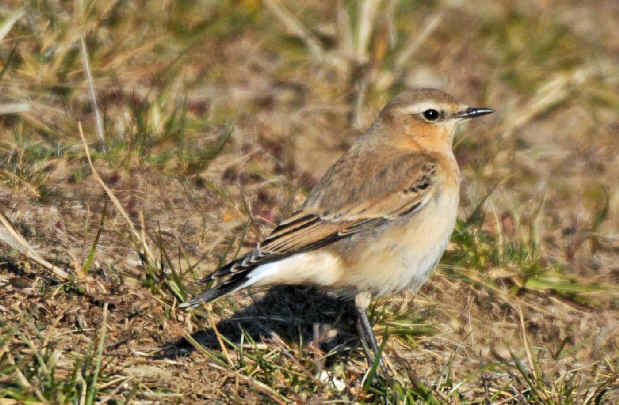
Below: A male Northern Wheatear during its breeding season in Iceland,
photographed there during the FONT tour in June 2015
(photo by Marie Gardner)

Pied Wheatear (*) (ph) ______
BU:may
Oenanthe pleschanka
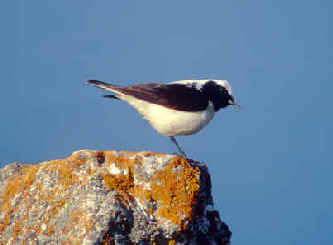
A Pied Wheatear in Bulgaria
"Western" Black-eared Wheatear
(Ev) (*) ______
PG:sep SP:apr,sep,oct
Oenanthe h. hispanica
"Eastern" Black-eared Wheatear
(*) ______
BU:may TU:aug
Oenanthe hispanica melanoleuca
Isabelline Wheatear (*) ______ BU:may
TU:aug
Oenanthe isabellina
Finch's Wheatear (*) ______ TU:aug
Oenanthe f. finschii
Black Wheatear (Ee) (*) ______ SP:jan,jun
Oenanthe l. leucura
Black Redstart (*) (ph) ______
AN:jun BU:may FR:jun HU:may PO:apr,may RM:may SP:jan,apr,jun,sep,oct,dec SW:sep TU:aug
Phoenicurus ochruros gibraltariensis (except
TU and most of SP)
Phoenicurus o. ochruros (TU)
Phoenicurus ochruros aterrimus (central and south SP)
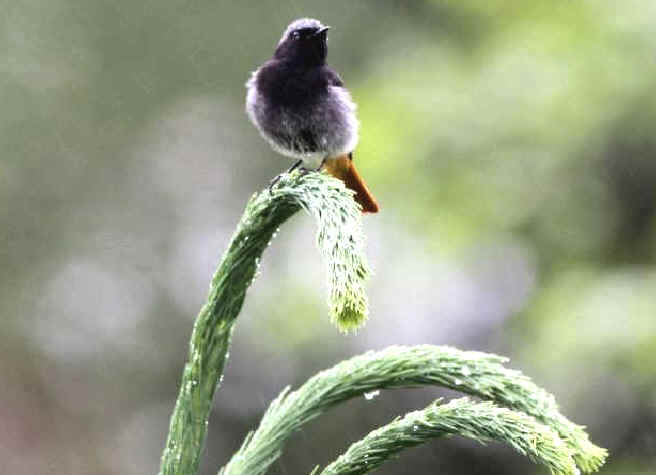
Black Redstarts. Above a male, below a female.
(upper photo by Przemyslaw Kunysz in Poland;
lower photo by James Scheib during a FONT tour in Sweden)
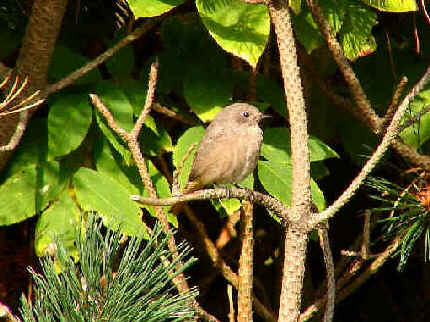
Common Redstart (Ev) (*) ______
AN:jun BU:may HU:may PO:apr,may RM:may SP SW TU:aug
Phoenicurus p. phoenicurus (except
TU)
Phoenicurus phoenicurus samamisicus (TU)
European Robin (*) (ph) ______ AN:jun
BU:may
CI:jun,jul FR:jun HU:may PO:apr,may RM:may
SL:may SP:jan,apr,jun,sep,oct.dec
SW:sep TU:aug
Erithacus r. rubecula (except
CI and south SP)
Erithacus rubecula superbus subspecies endemic in the
Canary Islands
Erithacus rubecula sardus (south SP)
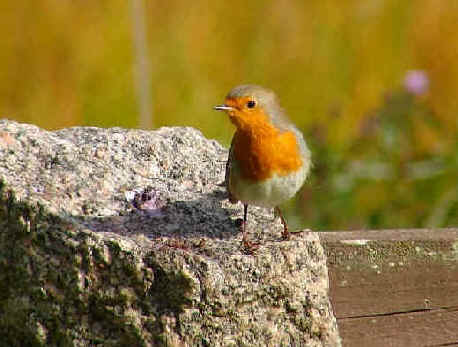
A European Robin photographed during a FONT tour
in Sweden in September 2007
(photo by James Scheib;
the other photo of the European Robin at the top of this list by Jens
Bruun)
Common Nightingale (*) ______ BU:may
FR HU:may PO:may RM:may SP:apr,jun TU:aug
Luscinia megarhynchos bachrmanni
(except SP)
Luscinia m. megarhynchos (SP)
Thrush Nightingale (or "Sprosser") (*)
______
BU:may PO:apr,may
Luscinia luscinia
Bluethroat (*) (ph) ______ HU:may
PO:apr,may SP:apr,jun,dec
Luscinia svecica cyanecula (except
SP)
Luscinia svecica nametum (SP)

A Bluethroat photographed during a FONT tour
Rufous-tailed
Scrub-Robin (*) ______ SP
Cercotrichas g. galactotes
Blue Rock Thrush (Ev) (*) ______ BU:may
GR:jun SP:apr,jun,sep,oct TU:aug
Monticola s. solitarius
Rufous-tailed Rock Thrush (Ed) (*) ______ BU:may RM:may SP:jun
Monticola saxatilis
Common Blackbird (*) ______ AN:jun
BU:may
CI:jun,jul FR HU:may IC:jun,sep PO:apr,may RM:may
SP:jan,apr,jun,sep,oct,dec SW:sep TU:aug
Turdus m. merula (except
CI and TU)
Turdus merula cabrerae subspecies endemic in the
Canary Islands
Turdus merula aterrimus (TU)
Ring Ouzel (*) (ph) ______ BU:may
PO RM:may
Turdus torquatus alpestris
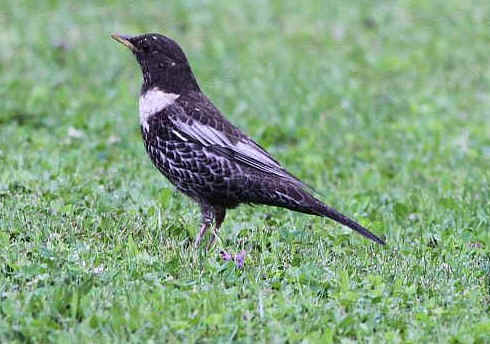
Ring Ouzel
(photo by Przemyslaw Kunysz)
Fieldfare (*) ______ PO:apr,may
RM:may SW:sep
Turdus pilaris
Redwing (*) (ph) ______ IC:may,jun,sep,oct
PO:apr
SP:dec SW
Turdus i. iliacus (except
IC)
Turdus iliacus coburni (IC)
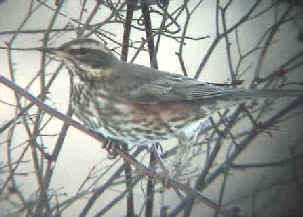
The Redwing is one of the most common landbirds in
Iceland,
during FONT tours in May & June and in September and October.
Song Thrush (*) ______ BU:may
FR:jun HU:may PO:apr,may RM:may SL:may SP:jan,dec SW;sep TU:aug
Turdus p. philomelos (in eastern Europe)
Turdus philomelos clarkei (in western Europe)
Mistle Thrush (*) ______ BU:may
HU:may PO:apr,may RM:may
SP:jun,sep SW:sep TU:aug
Turdus v. viscivorus
White-throated Dipper (*) ______ BU:may
RM:may PO:may
SP:apr,jun,sep TU:aug
Cinclus cinclus aquaticus (except
TU and north SP)
Cinclus c. cinclus (north SP)
Cinclus cinclus caucasicus (TU)
House Sparrow (i) (*) ______ AN:jun
BU:may
FR:jun HU:may IC:may PG:sep PO:apr,may RM:may
SL:may SP:jan,apr,jun,jul,sep,oct,dec SW:sep
TU:aug
Passer d. domesticus
Spanish Sparrow (*) ______ BU:may CI:jun,jul
SP:apr,jun TU:aug
Passer h. hispaniolensis
Eurasian Tree Sparrow (*) (ph) ______ BU:may
HU:may PO:apr,may RM:may SL:may SP:jun,dec SW:sep TU:aug
Passer m. montanus
Rock Sparrow (*) ______ CI:jul
SP:apr,jun TU:aug
Petronia petronia (the single member of its genus)
Petronia p. petronia (except CI)
Petronia petronia madeirensis subspecies endemic in the Canary
Islands
The Rock Sparrow is also called Rock Petronia.
Dunnock (*) ______ BU:may
FR:jun PO:apr,may RM SL SP:apr,jun,sep SW:sep TU:aug
Prunella m. modularis (except
SPf and TU)
Prunella modularis mabbotti (SPf)
Prunella modularis euxima (TU)
Alpine Accentor (*) ______ SP:jan
TU:aug
Prunella c. collaris (SP)
Prunella collaris subalpina (TU)
Tree Pipit (*) ______ BU:may
FR:jun HU:may PO:apr,may RM:may SP:apr SW:sep TU:aug
Anthus t. trivialis
Meadow Pipit (*) ______
BU:may IC:may,jun,sep,oct PO:apr,may SP:jan,apr,dec SW:sep
Anthus p. pratensis
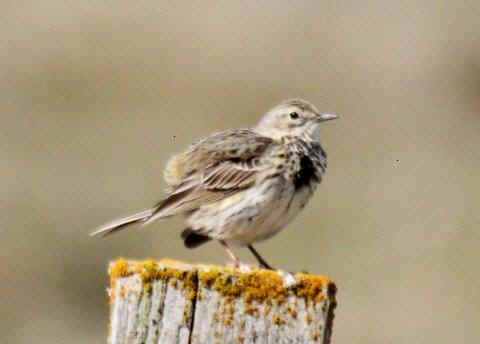
A Meadow Pipit photographed during
the FONT tour in Iceland in June 2012
(photo by Gabi Hauser)
Berthelot's Pipit (*) ______
CI:jun,jul a Macaronesian
endemic
Anthus b. berthelotii
Water Pipit (*) ______ AN:jun
BU:may
FR:jun PO:may SP:jan,jun,sep TU:aug
Anthus s. spinoletta (except
TU)
Anthus spinoletta coutellii (TU)
Eurasian Rock Pipit (*) ______
SW:sep
Anthus petrosus littoralis
The Eurasian Rock Pipit was conspecific with the Water Pipit (above).
Buff-bellied Pipit (Vna) (*)
______ IC:sep(rare)
Anthus rubescens
The 3 subspecies of Anthus rubescens
in North America are called the American Pipit.
By current taxonomy, another subspecies in eastern Asia, Anthus
rubescens japonicus, is called by its Old World name, Buff-bellied
Pipit.
It can assumed that this species, seen during a FONT tour in Iceland,
was a bird of American origin.
Red-throated Pipit (*) ______ BU:may
HU:may TU:aug
Anthus cervinus rufogularis
Tawny Pipit (Ev) (*) ______ BU:may
FR:jun HU:may PO:apr RM:may SP:apr,jun,sep TU:aug
Anthus c. campestris
Richard's Pipit (*) ______ SW:sep
Anthus richardi
White Wagtail (*) (ph) ______ AN:jun
BU:may
FR:jun HU:may IC:may,jun,sep,oct PO:apr,may RM:may
SP:jan,apr,jun,sep,oct,dec SW:sep TU:aug
Motacilla a. alba

White Wagtails photographed during FONT tour in Europe
Above in Sweden, below in Iceland
(upper photo by James Scheib; lower photo by Gabi
Hauser)
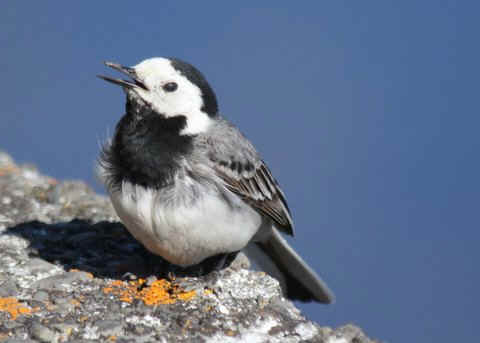
Grey Wagtail (*) ______
AN:jun BU:may CI:jun,jul
FR:jun HU:may PO:apr,may RM:may SP:jan,apr,jun,jul,sep SW:sep TU:aug
Motacilla c. cinerea (except CI)
Motacilla cinerea canaraiensis subspecies endemic in
the Canary Islands
Western Yellow Wagtail (*)
______ SP
Motacilla flava flavissima
The Western Yellow Wagtail has been split from the Eastern
Yellow Wagtail in eastern Asia and Alaska,
Motacilla tschutschensis.
The following 4 birds are forms, or subspecies, of the Western
Yellow Wagail.
""Blue-headed" Western
Yellow Wagtail (*) ______ BU:may
HU:may PO:apr,may
Motacilla flava flava
"Grey-headed" Western Yellow Wagtail
(*) ______
BU:may PO:may SW:sep
Motacilla flava thunbergi
"Black-headed" Western
Yellow Wagtail (*) ______ BU:may RM:may
TU:aug
Motacilla flava feldegg
"Iberian" Western Yellow Wagtail
(*) ______
PG:sep SP:apr,jun,jul,sep,oct
Motacilla flava iberiae
Citrine Wagtail (*) ______
PO:may
Motacilla citreola werae
Another name for Motacilla citreola
has been Yellow-hooded Wagtail
Common Chaffinch (*) (ph) ______ AN:jun
BU:may CI:jun,jul FR:jun HU:may PO:apr,may RM:may
SL:may
SP:jan,apr,jun,sep,oct,dec SW:sep TU:aug
Fringilla c. coelebs (except
CI and SP)
Fringilla coelebs canariensis (formerly F. c. tintillon)
subspecies endemic in the Canary Islands
Fringilla coelebs balearica (SP)
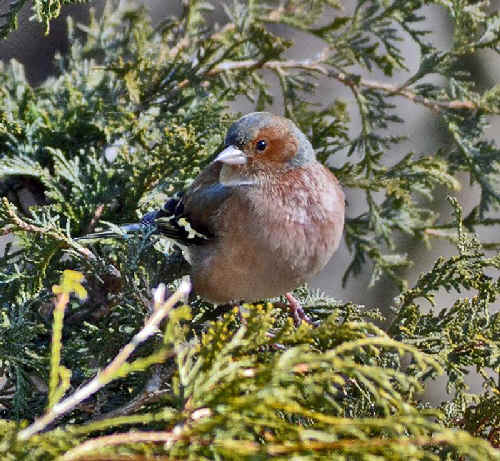
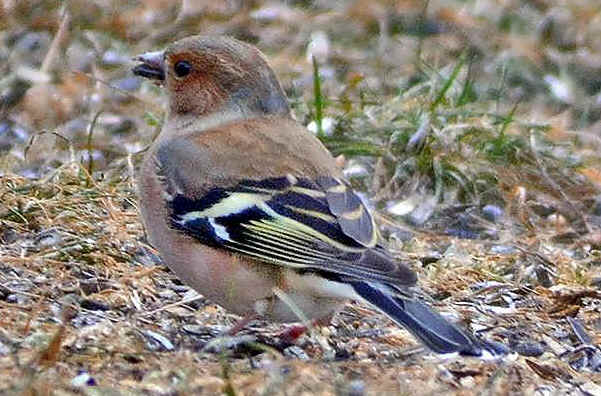
Two photos of the Common Chaffinch
(photos by Howard Eskin)
Blue Chaffinch (nt) (Ev) (*) ______ CI:jun,jul
an endemic species in the Canary Islands
Fringilla t. teydea
1 of the 2 subspecies in
the Canaries
Another name for Fringilla teydea
is "Teydefinch".
Brambling (*) (ph) ______
IC:jun(rare) PO:apr
SW;sep
Fringilla montifringilla
(monotypic)
European Goldfinch (*) ______ BU:may
CI:jul FR:jun HU:may PG;sep PO:apr,may RM:may
SL:may
SP:jan,apr,jun,sep,oct,dec SW:sep TU:aug
Spinus c. carduelis (formerly Carduelis c. carduelis)
(except CI,TU, and some in SP in the winter)
Spinus carduelis parva (CI)
Spinus carduelis niediecki (TU)
Spinus carduelis britannica (some in SP in the
winter)
Eurasian Siskin (*) (ph) ______ CI:jun
IC:jun,sep,oct PO:apr,may RM SP:jan,apr SW:sep
Spinus spinus (formerly Carduelis spinus)
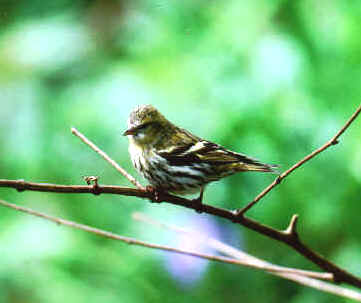
A female Eurasian Siskin photographed during a FONT tour
(photo by Paul West)
Common Redpoll (*) (ph) ______ SW:sep
Acanthis flammea cabaret (formerly Carduelis flammea cabaret) ("Lesser Redpoll")
"Icelandic" Common Redpoll
(*) ______
IC:may,jun,sep,oct
Acanthis flammea islandica (formerly Carduelis flammea islandica)
a subspecies of the Common Redpoll
Arctic Redpoll (*) ______
IC:sep(rare)
Acanthis hornemanni (formerly Carduelis
hornemanni)
Acanthis hornemanni hornemanni (*)
______ Hornemann's Arctic Redpoll IC:sep(rare)
Another name for the Hornemann's Arctic Redpoll is Greenland
Arctic Redpoll.
There is another subspecies called the Coues' Arctic Redpoll, Acanthis
hornemanni exilipes. It breeds on the tundra of Eurasia and
North America.
Acanthis hornemanni hornemanni is
paler than Acanthis hornemanni exilipes.
The Arctic Redpoll is called the Hoary Redpoll in North
America.
European Greenfinch (*) ______ AN:jun
BU:may
CI:jun,jul HU:may PO:apr,may RM:may SP:jan,apr,jun,dec SW:sep
TU:aug
Carduelis c. chloris (except
CI,SP,TU)
Carduelis chloris aurantilventris (CI,SP)
Carduelis chloris muehlei (TU)
Common Linnet (*) ______ BU:may
CI:jun,jul FR:jun HU:may PO:apr,may RM:may SP:jan,apr,jun,sep,dec
SW:sep TU:aug
Carduelis c. cannabina
(except CI,SP,TU)
Carduelis cannabina meadewaldoi 1 of 2 subspecies endemic in the Canary
Islands
Carduelis cannabina mediterranea (SP,TU)
Eurasian Bullfinch (*) ______ BU:may
PO:apr,may RM:may SL:may SP SW
Pyrrhula p. pyrrhula (except
SP)
Pyrrhula pyrrhula iberiae (SP)
Hawfinch (*) ______ BU:may
HU:may PO:apr,may RM:may
SP:jan,jun SW TU:aug
Coccothraustes c. coccothraustes
Citril Finch (*) ______
FR SP:jun
Carduelis citrinella (monotypic)
The Citril Finch was conspecific with what is now the Corsican
Finch, Carduelis corsicana, endemic
to that island in the Mediterranean.
European Serin (*) ______ AN:jun
BU:may FR:jun HU:may PO:apr,may RM:may
SP:jan,apr,jun,sep,oct,dec SW:sep TU:aug
Serinus serinus (monotypic)
Atlantic Canary (*) ______ CI:jun,jul
endemic species in the Canary Islands
Serinus canaria (monotypic)
Another name for Serinus canaria
is Island Canary.
Trumpeter Finch (Er) (*) ______
CI:jun,jul
Bucanetes githagineus amantum
endemic subspecies in CI
Common Rosefinch (*) (ph) ______
PO:may
Carpodacus e. erythrinus
Another name for Carpodacus erythrinus
is Scarlet Rosefinch.
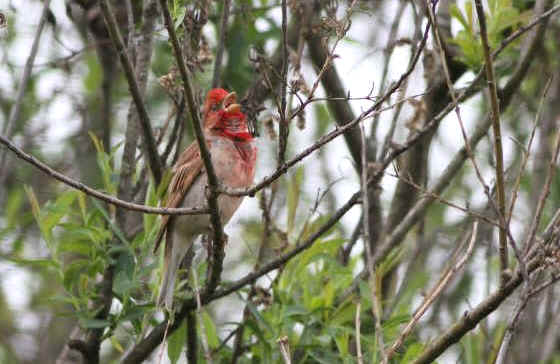
Common Rosefinch
(photo by Przemyslaw Kunysz)
Red Crossbill (*) (ph) ______ AN:jun
BU:may
FR:jun IC:oct(rare) RM:may
SL:may SP:jan,apr,sep SW
Loxia c. curvirostra
Another name for Loxia curvirostra
is Common Crossbill.
Parrot Crossbill (*) ______
SW
Loxia pytyopsittacus
Two-barred Crossbill (*) (ph) ______ SW
Loxia leucoptera bifasciata
Loxia leucoptera
is called White-winged Crossbill in North America.
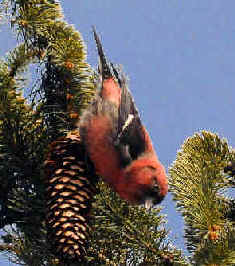
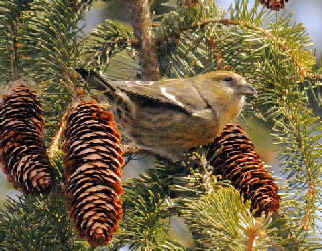
Two-barred, or White-winged Crossbills
Male, above; female, below.
(photos by Howard Eskin
Corn Bunting (*) ______ BU:may
CI:jul HU:may PO:apr,may RM:may SL:may SP:jan,apr,jun,sep,dec
SW:sep TU:aug
Emberiza c. calandria (formerly Miliaria c. calandria)
(except CI)
Emberiza calandria thanneri (formerly Miliaria calandria thanneri)
(CI)
"Western" Rock Bunting (Ev)
(*) ______
BU:may FR RM SP:jan,apr,jun,sep,oct TU:aug
Emberiza c. cia
Cirl Bunting (*) ______ BU:may
SP:jan,apr,jun TU:aug
Emberiza cirlus
(monotypic)
Yellowhammer (*) (ph) ______ AN:jun
BU:may HU:may PO:apr,may RM:may
SP:sep SW:sep
Emberiza c. citrinella
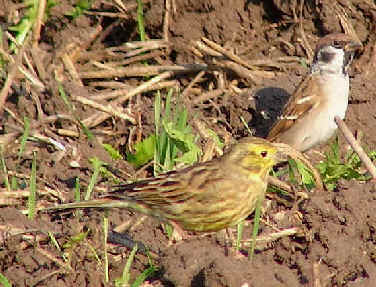
A Yellowhammer & an Eurasian Tree Sparrow on Oland Island
during the September 2007 FONT Sweden Tour
(photo by James Scheib)
Ortolan Bunting (Ev) (*) ______ BU:may
PO:apr,may RM:may
SP:apr,jun,sep
Emberiza hortulana (monotypic)
Black-headed Bunting (Ev) (*) ______ BU:may
Emberiza melanocephala (monotypic)
Common Reed Bunting (*) ______ BU:may
HU:may PO:apr,may SP:jun,dec SW:sep
Emberiza s. schoeniclus (except
HU and SP)
Emberiza schoeniclus stresmanni (HU)
Emberiza schoeniclus witherbyi (SP)
Snow Bunting (*) (ph) ______
IC:may,jun,sep,oct SW:sep
Calcarius n. nivalis (formerly Plectrophenax n. nivalis)
(SW)
Calcarius nivalis insulae (formerly Plectrophenax nivalis insulae) (IC)
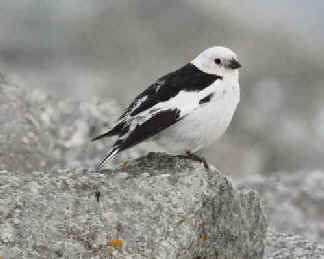
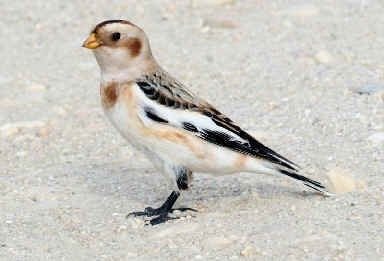
Snow Buntings are seen in Iceland during FONT tours
in both the late spring and the fall.
(upper photo by Marie Gardner, during the FONT
Iceland Tour in June 2015,
lower photo by
Howard Eskin)
Excellent reference and guide books for the birds of Europe include:
"Complete Guide to the Birds of Europe", with text by Lars Svensson and Peter Grant,
illustrated by Killian Mullarney and Dan Zetterstrom,
1999. Harper Collins & Princeton Univ Press
"Birds of Europe with North Africa
& the Middle East",
by Lars Jonsson, 1993, Princeton Univ Press
Other related books:
"Raptors of the World", by James Ferguson-Lee & David Christie,
2001, Houghton Mifflin
"Icelandic Bird Guide", by Oli Johann, 2000, Prentsmidjan Oddi hf.
"Owls - A Guide to the Owls of the World", by C. Konig, Friedhelm
Weick, & Jan-Hendrik Becking, 1999, Yale University Press
"Owls of Europe", by Heimo Mikkola, 1983, T & A D Poyser
"Guia de las Aves de las Islas Canarias", by Jose manuel Moreno, 1988,
Editorial Interinsular Canaria, S.A.
"La Guia de Incafo de las Aves de la Peninsula Iberica", by Ramon
Saez-Royuela, 1980, Incafo.
"Woodpeckers - An Identification Guide to the Woodpeckers of the
World", by Hans Winkler, David Christie, & David Nurney, 1995, Houghton
Mifflin
To
top of page


 Birds
of EUROPE
Birds
of EUROPE











































